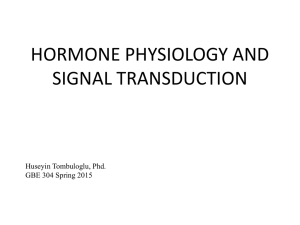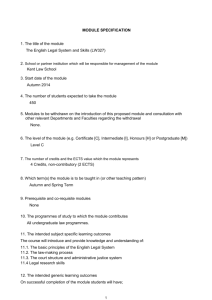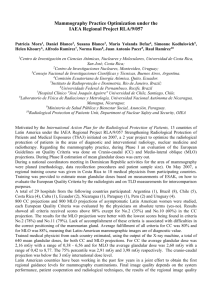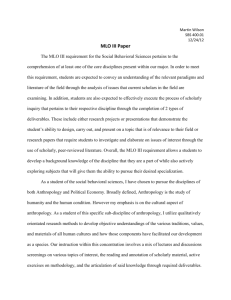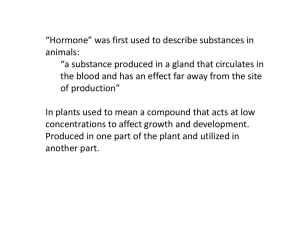Tissues of photoautotrophic plants are generally addressed as
advertisement
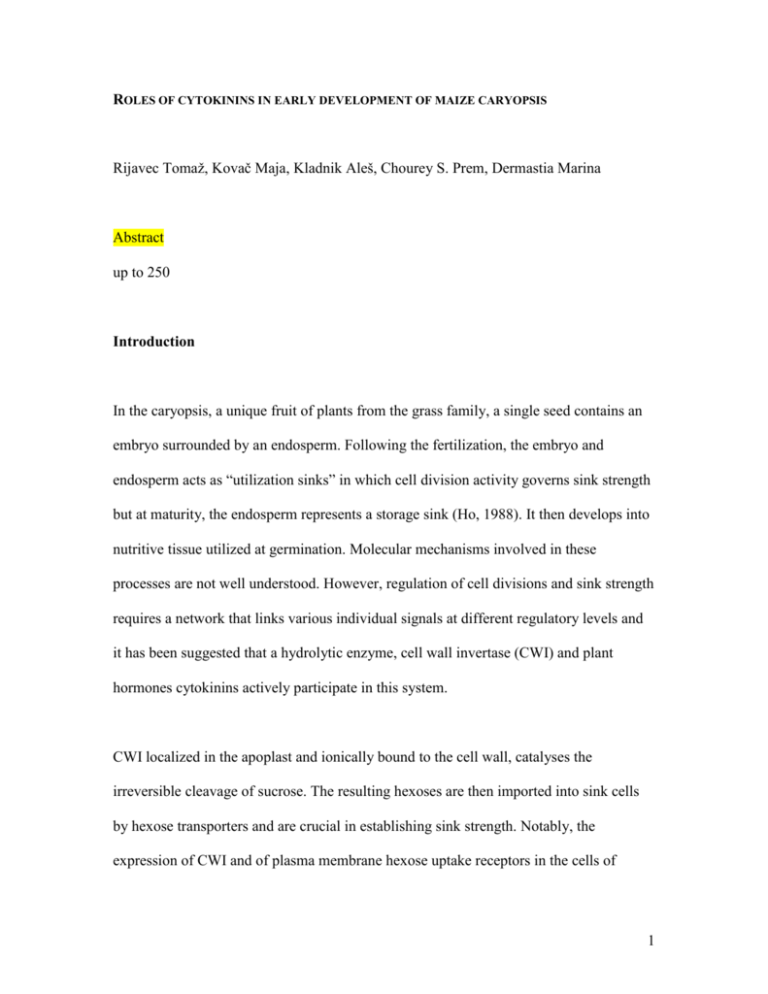
ROLES OF CYTOKININS IN EARLY DEVELOPMENT OF MAIZE CARYOPSIS Rijavec Tomaž, Kovač Maja, Kladnik Aleš, Chourey S. Prem, Dermastia Marina Abstract up to 250 Introduction In the caryopsis, a unique fruit of plants from the grass family, a single seed contains an embryo surrounded by an endosperm. Following the fertilization, the embryo and endosperm acts as “utilization sinks” in which cell division activity governs sink strength but at maturity, the endosperm represents a storage sink (Ho, 1988). It then develops into nutritive tissue utilized at germination. Molecular mechanisms involved in these processes are not well understood. However, regulation of cell divisions and sink strength requires a network that links various individual signals at different regulatory levels and it has been suggested that a hydrolytic enzyme, cell wall invertase (CWI) and plant hormones cytokinins actively participate in this system. CWI localized in the apoplast and ionically bound to the cell wall, catalyses the irreversible cleavage of sucrose. The resulting hexoses are then imported into sink cells by hexose transporters and are crucial in establishing sink strength. Notably, the expression of CWI and of plasma membrane hexose uptake receptors in the cells of 1 Chenopodium rubrum in suspension culture is enhanced by cytokinins (reviewed by Roitsch and Gonzáles, 2004). Cytokinins play a crucial role in regulating proliferation and differentiation of plant cells, and also control various processes in plant growth and development (reviewed in Sakakibara, 2006). The up-regulation of CWI by cytokinins has a dual function, providing carbohydrates to the actively growing tissues and generating a metabolic signal to stimulate the cell cycle. This mechanism ensures that cell proliferation is only initiated when sufficient carbohydrates are available to satisfy the increased demand for nutrients by the actively dividing cells (reviewed by Roitsch and Gonzáles, 2004). In the work reported here we analyzed cytokinin metabolites in miniature1 (mn1) maize seed mutant to evaluate their possible contribution to its development. mn1 shows a drastic reduction in endosperm size compared with that of the wild type, Mn1, with the weight of the mature mn1 endosperm being only 30 % that of the wild type (Lowe and Nelson, 1946). Its overall decrease in size at 16 days after pollination (DAP) is associated with a reduced mitotic activity in the developing endosperm (Vilhar et al. 2002). The causal basis of the mn1 seed phenotype is the loss of one of the two CWI isoforms, INCW2, encoded by the Mn1 gene (Miller and Chourey, 1992; Cheng et al., 1996), which is specifically expressed at the base of the endosperm (Cheng et al., 1996). The current cytokinin study in maize caryopses together with previous findings provides evidence for possible crosstalk between CWI, cell cycle and cytokinins during early development of maize caryopsis. Additionally, we show the potential association of cytokinins with the beginning of the programmed cell death (PCD) in the placento- 2 chalazal (P-C) layer just below the developing endosperm in the caryopsis pedicel (Kladnik et al., 2004, 2005). Material and Methods Plant Material Immature maize (Zea mays L.) kernels of Mn1 and the mn1 reference allele in the W22 inbred line were harvested at 4, 6, 8, 12, 16, and 20 days after pollination. Plants were grown in the field (green house???) in the summer of either 2006 or 2007 and selfpollinated by hand. Caryopses were individually excised from the ear, taking care to include the pedicel region. Caryopsis were immediately frozen in liquid nitrogen. Frozen samples were stored at -80 °C until cytokinin analysis. Prior the analysis, the caryopses were divided with a razor blade just above the pedicel to upper and basal part. Basal sections of 6 DAP -old-caryopses included mostly maternal nucellar tissue and pedicel together with the P-C layer; and that of older one additionally included associated basal endosperm transfer layer. In caryopses older than 8 DAP this section represented the sucrose turnover region. Upper sections contained nucellar tissue and pericarp in 6 DAPold-caryopses and in older ones also the upper endosperm tissue and aleurone. Therefore, the upper section was the storage region of developing caryopsis. ALEŠ 3 Cytological measurements : TO BE IN SUPPLEMENT Number of cells, MCDT, Growth rate Cytokinin analysis TOMAŽ: to je iz mojih člankov, ustrezno popravi Plant material was extracted in 80 % cold methanol, the methanol was evaporated, and the residue dissolved in 3 ml of 1 M formic acid. the solution was first passed through a polyvinylpolypyrrolidone column to reduce the content of phenols and quinines , and then evaporated. The cytokinin metabolites were isolated and analyzed by a modified immunoaffinity chromatographic system described by Dermastia et al. 1994, 1996, using immunoaffinity columns with monoclonal antibodies against (NAŠTEJ VSE, TUDI AROMATSKE) (FIRMA, Czech Republic). Sample, eleuents and columns were heated to 30 °C. The flow rate was kept between 1-2 ml min-1 during sample loading and washing. A maximum of 10 ml of sample was applied to each column. The columns were washed with 15 ml PBS (pH 7) and eluted wit 2 ml H2O, 2 ml 15 % methanol, 2 ml 30 % methanol, and 3 ml 100 % methanol. Eluates were then pooled. affinity purified material was separated by HPLC. the binding of a particular cytokinin standard onto the immunoafinity column was determined by applying a mixture of standards (all from FIRMA, Czech Republic) diluted in 2 ml of PBS to the column. Washing and eluting were as described above. Samples were applied to a HPLC (KATERA, FIRMA) column (DIMENZIJE; VELIKOST PARTICLOV) in a strating buffer of 1 mM triethylamine (pH 7), containing a 10 % mixture of methanol-acetonitrile (1 : 1, v/v). The column was eluted with an organic solvent gradient increasing from 10 to 20 % over 25 min, 4 followed by an increase from 20 to 30 % over 30-40 min. The retention times for all cytokinin standards were checked and the corresponding HPLC fractions were collected for further identification. HPLC peaks were quantified by integrating the areas under the peaks measured at 265 nm and comparing with areas of known standard quantities. Recoveries of PROCENT were obtained after elution of the immunoaffinity columns and HPLC separation. The values were corrected for the losses. The purity of HPLC fractions corresponding to standars was estimated by scanning the interval between 220 and 300 nm with a Hewlett Packard 8452A diode array spectrophotometer. The sample spectra were further compared with the spectra of the standards. Because the collective results provided evidence that the period between 8 and 12 DAP is key for further caryopsis development, more detailed analysis with additional samples in two different growing seasons were done for 8- and 12 DAP-old caryopses. Results and Discussion Cytokinins as possible inducers of PCD Maize endosperm undergoes distinct development stages. Following fertilization, the primary endosperm nucleus passes through multiple rounds of division without cytokinesis, resulting in syncytium or multinucleate cytoplasm. Then, cellularization results in discrete cells filling the central cell and is complete around 4 DAP (Kowles and Phillips, 1985). At that time the endosperm of mn1 had a similar number of cells compared with that of the Mn1 (Fig. 1, Fig. S1). 5 At 6 DAP the total cytokinin concentrations in the Mn1 and mn1 caryopses were 16 and 12.2 nmol g-1 DW, respectively. Cytokinins were uniformly distributed between basal and upper sections (Table 1) that mostly consisted of the maternal nucellar tissue at this developmental stage (Fig. S1). At 8 DAP, 13 to 14.7 nmol g-1 DW of the total cytokinins were detected in the caryopses of both genotypes (Fig. 1). In contrast with the 6 DAP stage, there was a 50 % difference in the concentration of all detected cytokinin species between basal and upper section (Table 1). Beside the similar pattern of Z, ZR and iPA at early stages of caryopsis development as shown by Brugière et al. (2003), we reported here, for the first time in maize caryopses, the presence of DHZ, DHZR and Z-9-G (Table 1, Fig. 2). Very high cytokinin concentrations in the period between 7 and 10 DAP have been reported previously and they were solely correlated with a peak of cell divisions in the endosperm (Jones et al. 1990; Dietrich et al. 1995; Brugière, 2003). However, our previous detailed cytological analysis has revealed that the period between 4 and 8 DAP corresponds to the beginning of the progressive PCD in the P-C layer of both genotypes examined here. The P-C layer developed through the PCD has been shown as an important region for the transport of carbohydrates and water to the growing endosperm and embryo. The P-C layer PCD occurs in two distinctive sub-domains based on their developmental origins. PCD in the nucellar part of the P-C layer starts as early as 4 DAP and shows characteristics of the vacuolar type; and that in the integumental P-C layer starts at 8 DAPS and was more apoptotic-like. Especially the vacuolar PCD shows 6 several similarities with the development of the xylem elements (Kladnik et al. 2004). The differentiation of latter is associated with cytokinin sensing (Mähönen et al., 2000). In addition, exogenous application of cytokinins at very high dosages (e.g. in micromolar concentrations) to cell suspensions of Arabidopsis and Daucus carotta can induce senescence and PCD (Carimi et al.2003, 2004). Regarding the high cytokinin concentration in the basal section (Table 1), which temporally and spatially coincides with the onset of PCD in the P-C layer (Kladnik et al. 2004), the association of cytokinins and the PCD triggering might be suggested, although direct mechanistic links have yet to be established. In supporting this idea are more than ten-times lower concentrations of cytokinins in Mn1 at 12 DAP (Table 1, Fig. 1), which were sufficient for normal cell divisions in developing caryopsis (Fig. 1, Fig. S1). Furthermore, the available data on endogenous cytokinin concentrations in different plants and plant organs (Dermastia 1994, 1995, 1996; Sáenz et al. 2004; Arthur et al., 2007; Criado et al., 2007) are in order of magnitude lower as reported here at 6 and 8 DAP. N9 glucosylation is important factor for diminishing active cytokinin forms in caryopsis Cell divisions between 8 and 12 DAP establish the basic cell number for the body of the endosperm and may be important for grain yield (Kowles and Phillips, 1985; Schweizer et al., 1995). Daughter cells maintained the initial 3C DNA content (Fig. S1) and were of the same size in both genotypes (Fig.S2), indicating a normal mitotic cycle (Francis, 2007). The increasing growth rate of the wild type endosperm with its peak at 12 DAP (Fig. S3) correlates with the increasing activity of INCW2, the missing enzyme in mn1 7 (Cheng et al., 1996; Cheng and Chourey, 1999). However, the same period in mn1 was marked by a much lower growth rate (Fig. S3). After 8 DAP the mean cell doubling time progressively lengthened in mn1 and was for 1.79-fold longer than in Mn1 in the interval between 10 – 12 DAP. Cell divisions cease in the central endosperm by about 12 DAP, but continue until late developmental stages in the peripheral cell layers, away from the embryo to support the expanding endosperm below (Fig., S1) (Kiesselbach, 1949; Kowles and Phillips, 1985, 1988, Vilhar et al., 2002). At that time a substantial drop in total cytokinin concentration was detected in the caryopses of both genotypes (Table 1, Fig. 1, Fig. 2). The cytokinin concentration in Mn1 decreased by 13-times at 12 DAP compared to 8 DAP, while at the same time, it dropped only four-times in mn1 (Table 1, Fig. 1, Fig. 2). The decrease in overall cytokinin concentration was in correlation with a diminished diversity of cytokinin forms, which was emphasized in Mn1 (Table 1, Fig. 2). The consensus is that cytokinin oxidase (Ckx) is the primary means of irreversible cytokinin degradation and thus an important mechanism by which plants modulate their cytokinin level (Sakakibara, 2006). Its high enzymatic activity and gene expression level in maize at the times examined here have been shown (Bilyeu et al. 2001, 2003; Brugière et al. 2003; Massonneau et al. 2004). Between 12 and 20 DAP an important part of maize cytokinins in caryopses comprised Z-9-G. Notably, in Mn1 22-29% of the total detected cytokinins were in the 9-glucolized form, while in mn1 before 20 DAP only a small portion of cytokinins represented Z-9-G 8 (Table 1, Fig. 3). In addition to degradation with Ckx, the steady-state levels of active cytokinins in planta may also be regulated by a glucosylation at N3, N7, N9 position of the cytokinin purine moiety or at hydroxyl group (Sakakibara, 2006). Because Nglucosides are not efficiently cleaved by β-glucosidase; N-glucosylation is practically irreversible (Brzobohaty et al. 1993). Model which explains the alternative growth pathways of Mn1 and mn1 regulated by cytokinins Roitsch and Gonzáles (2004) proposed a model, showing how CWI could contribute to the sink strength and sink size regulated by cytokinins. According to the model, CWI enhances the sink strength by increasing the flow of photosynthates to sink tissues and links the metabolic sugar signal to the regulation of the cell cycle via D-type cyclins to increase sink size. The model explains at least to some extent the phenotypical and developmental features of mn1 maize seed mutant. The model (Fig. 4) implies that in cooperation with remaining 25 to 30 % activity of INCW2 (Cheng et al. 1996) the present cytokinin concentration is enough for maintaining cell divisions in the sub-aleurone layer of the Mn1 caryopsis. On the contrary, lower concentration of metabolically inactive cytokinins and their lower degradation by Ckx in mn1 might partially compensate the absence of INCW2 in regulating cell divisions by cytokinins and CycD3 in the later stages of endosperm development. 9
